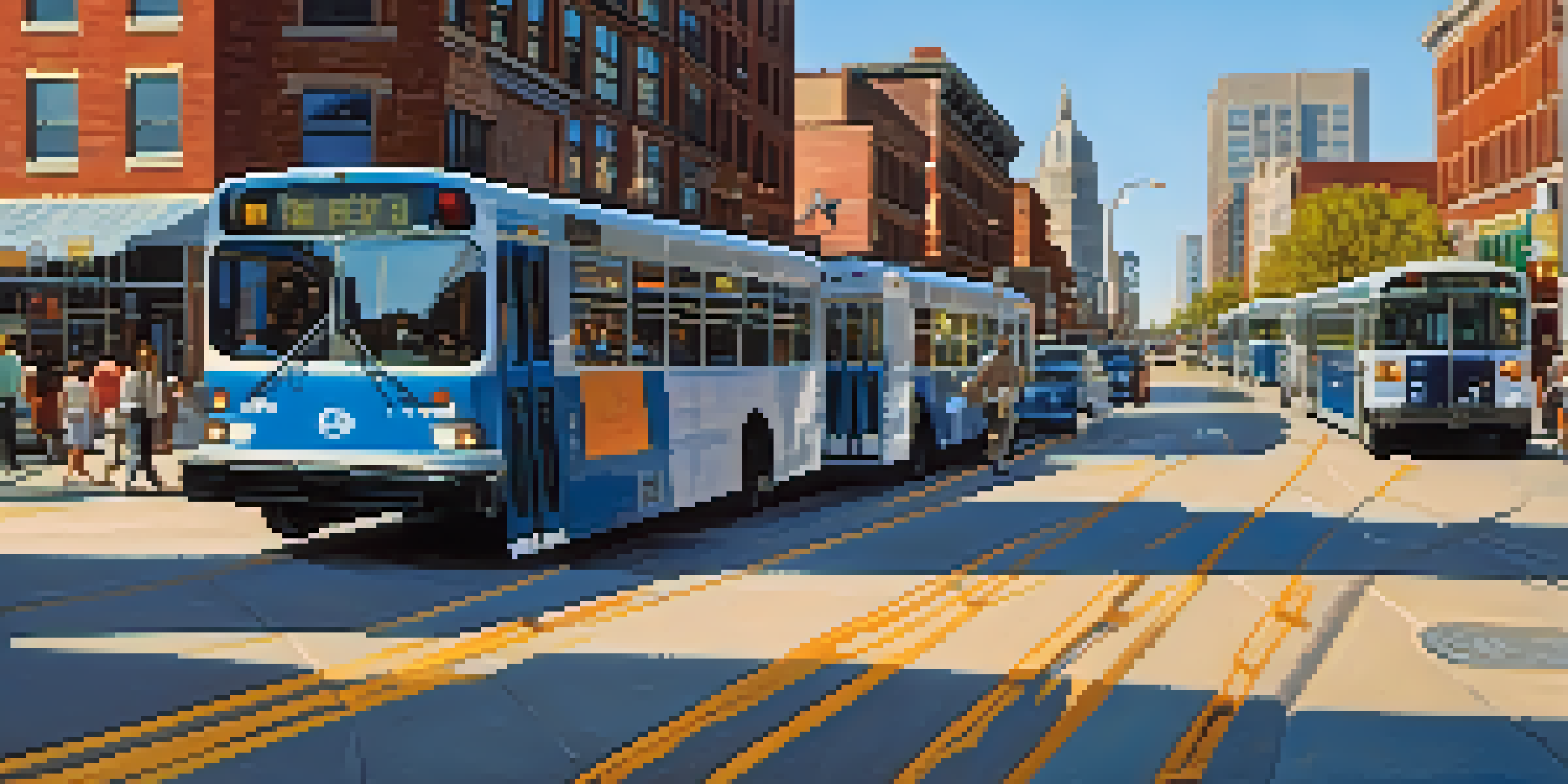Public Transit vs. Driving: St. Louis Commuter Choices

Understanding the Commuter Landscape in St. Louis
St. Louis offers a mix of commuting options that cater to diverse needs. With a population that leans towards both public transit and personal vehicles, understanding the commuter landscape is essential. Factors like job locations, urban density, and socioeconomic status play pivotal roles in choosing how to travel.
The journey of a thousand miles begins with one step.
Many residents find themselves weighing the pros and cons of each option, often influenced by convenience, cost, and time. For instance, those who work in the city center might find public transit more appealing due to its accessibility. Meanwhile, suburban commuters may lean towards driving for flexibility and comfort.
Ultimately, the choice between public transit and driving is a reflection of individual circumstances, making it crucial to consider what works best for your lifestyle.
The Benefits of Public Transit in St. Louis
Public transit in St. Louis, including buses and light rail, offers several advantages that can enhance your daily commute. One of the most significant benefits is cost-effectiveness; monthly passes can save commuters a substantial amount compared to the expenses of owning a car. Additionally, public transit can help reduce traffic congestion, contributing to a more efficient city.

Another perk is the opportunity to relax or be productive during your commute. Instead of focusing on the road, you can read, catch up on emails, or simply enjoy the scenery. This can be particularly appealing for those who dislike the stress of driving in heavy traffic.
Public Transit's Cost Advantages
Public transit in St. Louis offers significant savings compared to the costs associated with owning a car.
Moreover, using public transit supports environmental sustainability, as it reduces carbon emissions compared to individual car use. This aligns with a growing trend toward eco-friendly living, making it an attractive choice for many St. Louis residents.
The Drawbacks of Public Transit to Consider
While public transit has its benefits, it also comes with some drawbacks that commuters should keep in mind. One common issue is the unpredictability of schedules; delays and crowded buses can lead to frustration, especially during peak hours. This can be a significant downside for those who are pressed for time.
Life is a journey, not a destination.
Additionally, public transit may not always provide direct routes to your destination. Commuters might need to make transfers or walk longer distances, which can be inconvenient. For individuals with mobility challenges, this can pose an even greater obstacle.
Lastly, safety and cleanliness can be concerns on public transportation. Passengers may feel uneasy during busy hours or in certain neighborhoods, impacting their overall commuting experience.
The Advantages of Driving in St. Louis
Driving in St. Louis offers a level of convenience that public transit often can't match. With a personal vehicle, commuters have the freedom to set their own schedules, making it easier to accommodate unexpected changes throughout the day. This flexibility is invaluable for busy professionals and families.
Moreover, driving provides direct access to your destination without the need for transfers or long walks. This can be particularly beneficial for those who work in areas with limited public transit options or for those with heavy loads, such as parents with children or individuals carrying equipment.
Driving Offers Greater Flexibility
Having a personal vehicle allows commuters to set their own schedules and access direct routes, providing unmatched convenience.
Lastly, driving allows for a sense of personal space and comfort that public transit may lack. Whether it's enjoying your favorite music, having air conditioning on a hot day, or simply being able to leave personal items in your vehicle, the car can feel like a sanctuary during your commute.
The Downsides of Driving to Keep in Mind
Despite its advantages, driving in St. Louis isn't without its challenges. Traffic congestion can be a major headache, especially during rush hour, leading to longer commute times than anticipated. This can turn a simple drive into a frustrating experience, eating into your valuable time.
The costs associated with owning a car can also add up quickly. From fuel expenses to insurance, maintenance, and parking fees, driving can become a financial burden for many. This is especially true for those who commute daily, as these expenses can significantly impact a budget.
Additionally, driving contributes to environmental issues, such as air pollution and greenhouse gas emissions. As awareness grows around sustainability, many commuters are reconsidering their reliance on personal vehicles, seeking greener alternatives when possible.
Comparing Costs: Public Transit vs. Driving
When deciding between public transit and driving, cost is often a major factor. Public transit systems typically offer affordable options, such as monthly passes and discounts for students or seniors. In contrast, the expenses of owning a car, including fuel, maintenance, and insurance, can quickly accumulate, making public transit a more budget-friendly choice.
For example, consider a monthly transit pass that costs around $70 compared to the average monthly cost of owning a car, which can easily exceed $500 when factoring in all associated costs. This substantial difference can heavily influence a commuter's choice, especially for those on a tight budget.
Weighing Pros and Cons Matters
Choosing between public transit and driving depends on individual circumstances, including budget, convenience, and lifestyle needs.
However, it's important to note that the cost-effectiveness of each option can vary depending on individual circumstances, such as distance traveled or job location. Thus, it's essential for commuters to evaluate their specific situations when weighing these costs.
Final Thoughts: Making the Right Choice for You
Ultimately, the choice between public transit and driving in St. Louis comes down to personal preference and individual circumstances. Both options have their pros and cons, and what works for one person might not work for another. Understanding your commuting needs, budget, and lifestyle can help you make an informed decision.
Consider trying out different options to see what fits best. For instance, you might find that public transit works well for weekdays, while driving is more suitable for weekends and errands. This flexibility can provide the best of both worlds.

Whatever you choose, the key is to prioritize what makes your commute easier and more enjoyable. After all, a smoother commute can lead to a better overall quality of life.